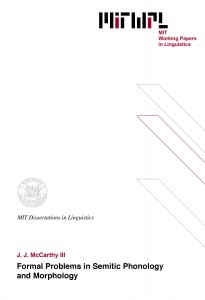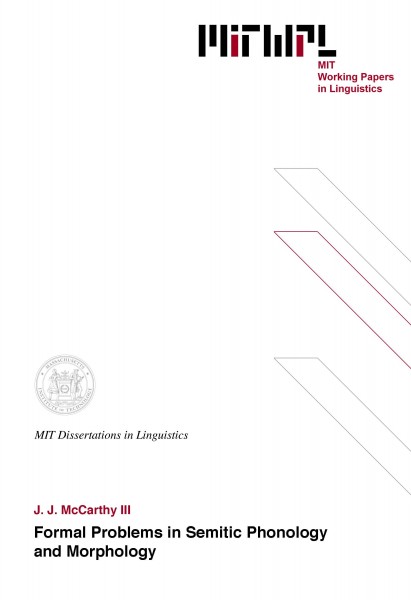Formal Problems in Semitic Phonology and Morphology
J. J. McCarthy III, 1979
This study deals with the formal character of phonological representations and rules. Two basic lines of investigation are pursued. One, the metrical, holds that there is hierarchic metrical structure within syllables and accentual groups. A metrical theory of syllable structure and of stress is elaborated based on data from Tiberian Hebrew, Classical Arabic, and the modern Arabic dialects of Cairo and Damascus. The effects of syllable structure on the form and function of segmental phonological rules are adumbrated with data from Tiberian Hebrew as well. The role of metrical structure in vowel harmony also figures briefly.
The other formal line followed is prosodic. An essentially autosegmental theory of nonconcatenative morphology is developed and extensively illustrated with data from Classical Arabic and Tiberian Hebrew. A general constraint limiting the morphology to context-sensitive rewrite rules is developed and defended on the basis of this theory. The prosodic model is also shown to solve several traditional problems in the characterization of reduplication phenomena. Finally, a theory of internally-structured lexical entries is proposed and is demonstrated to have significant empirical consequences within this morphological system.
Thesis Supervisor: Morris Halle
Title: Ferrari P. Ward Professor of Modern Languages and Linguistics
Table of Contents
Chapter 1 Prologue 9
Chapter 2 Syllable structure and segmental phonology
1 Introduction 14
2 Syllable structure 16
3 Syllabic structure and phonological rules 30
4 The segmental phonology of Tiberian Hebrew 35
Footnotes 76
Chapter 3 Syllable structure and accentuation
1 Introduction 78
Excursus: foot structure in English 92
2 Stress assignment in Arabic 101
2.1 Cairene colloquial 101
2.2 Damascene colloquial 118
2.3 Classical Arabic 127
2.4 Diachronic considerations 131
3 The accentual system of Tiberian Hebrew 135
3.1 Introduction 135
3.2 Main stress 139
3.3 The rhythm rule 145
3.4 Imperfect consecutive stress retraction 165
3.5 Perfect consecutive stress shift 170
3.6 Secondary stress 180
3.7 Summary 191
4 Nonprosodic metrical structure 193
4.1 Tigre 198
4.2 Maltese 203
Footnotes 206
Chapter 4 Prosodic structure, morphology, and the lexicon
1 Introduction 209
2 Basic formalism 218
2.1 The representation of morphemes 218
2.2 Autosegmental theory 230
3 The Classical Arabic verbal system 239
3.1 Consonantism 245
3.2 Vocalism 281
3.3 The first Binyan 290
3.4 Subject agreement 295
4 The Classical Arabic nominal system 304
4.1 Nouns with m-preformative 305
4.2 Masdars 321
4.3 Diminutive and broken plurals 330
4.3.1 Quadriliteral nouns 332
4.3.2 Nouns CVVCV(V)C 337
4.3.3 Nouns CVCVVC 340
4.3.4 Nouns CVC(V)C 343
5 Theoretical consequences
5.1 Formal properties of morphological rules 356
5.2 Morphology and the lexicon 387
5.2.1 The structured lexical entry 393
5.2.2 Lexical idiosyncracy 408
Footnotes 417

